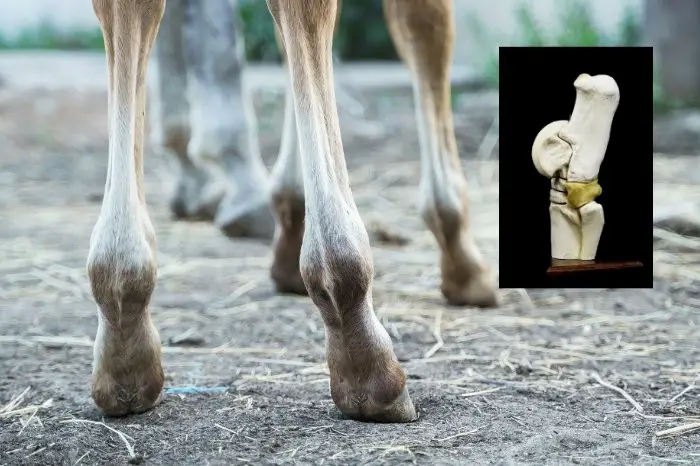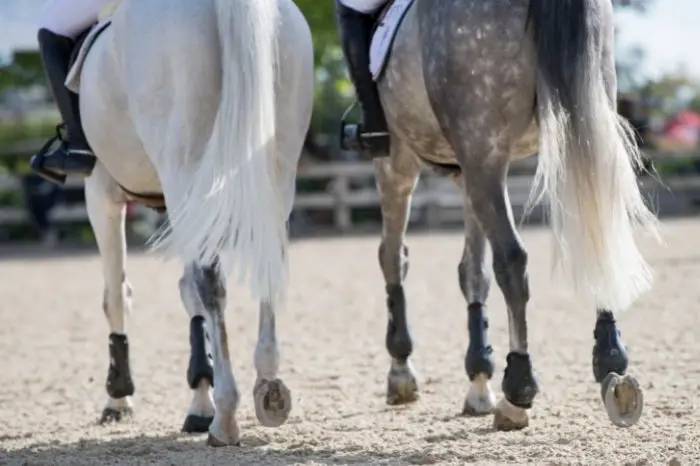Last Updated on January 24, 2022
This might sound crazy, but horses’ legs are very similar to human anatomy in many ways! They have many of the same bones and joints, but they are very different in size and strength. But do horses have knee caps, and where are they located?
If you want to learn about horse anatomy, an easy way to do this is to compare equine to human bone structure. All mammals are very similar in terms of their skeletal system but have some key differences. Let’s take a look at horse limb anatomy and find out where their knee caps are!
Do Horses Have Knees On Back Legs?
Where the knee of a horse is located is something that many people get confused about. On a human, our knees are on our legs, but what about a horse?
Well, it isn’t quite that straightforward! In this article, we are going to talk about two different joints in the horse’s legs. One of these is the joint that is called the knee in the horse, and the other is the joint that is the equivalent of the human knee.

Don’t worry if this sounds confusing, as it is something that most of us get muddled up about! We are now going to figure out just what these two joints are, and if horses do have knee caps.
When we are describing horses, we call the large knobbly joint halfway down the foreleg the knee. The joint above this is called the elbow, and the joint below is the pastern. However, the joint in the horse that we call the knee is not the same joint as the human knee!
This joint in the foreleg is correctly known as the carpus, and in a human, the equivalent joint would be the wrist.
In human anatomy, the knee is called the femorotibial joint. The same joint in the horse is in the hindlimb and is referred to as the stifle joint. So, yes, horses do have knees on their back legs, but we call them by a different name!
Read more about Doing Your Own Horses Teeth – Is It A Good Idea?
Where Is The Kneecap On A Horse?
The horse does have a knee cap, and this is part of the stifle joint. The correct name for this bone is the patella and it forms the femoropatellar joint. The patella is a relatively small bone and sits over the front of the femorotibial joint.
The role of the patella, or knee cap, is to act as a pulley for the muscles and ligaments in the hind leg. This greatly increases the strength and range of motion of the horse’s back leg.
So, not only do horses have knee caps, but this tiny bone also has a very important role to play!

Horse Knee Anatomy Explained
So, now we understand how the stifle in the hind leg works, what about the joint in the foreleg that we call the knee on a horse? The carpus is another complex joint, uniquely adapted to give a horse the strength and agility to be able to run and jump.
The carpus of a horse consists of two rows of cube-like bones. There are three bones in each row, plus an extra bone at the back of the upper row. This is called the accessory carpal bone and you will be able to easily feel this at the back of your horse’s knee joint.
These two rows of bones are separated by a joint, as well as a joint above and below the rows. This means that the horse has a total of three separate joints in the carpus. It is these three joints that give the horse, its incredible flexibility in the foreleg.
Check Out Best Names For Colored Horses
What Causes Capped Knees In Horses?
You may have heard someone say that a horse has capped knees, but what is this and what causes it?
Capped knees is a problem that occurs in the carpus of the horse, one of the main joints in the equine foreleg. You may also hear people refer to this disorder as popped knees. The correct name for this disorder is carpal bursitis.
Horse Health Joint Combo Hoof & Coat 3.75 pounds 30 day supply
This condition occurs as a result of damage to the synovial structures that surround the bones and tendons of the knee. A synovial structure is a fluid-filled sac that protects hardworking areas from damage.
When a horse has capped knees, one or more of these structures has become damaged and enlarged. This will protrude from the front of the horse’s knee, giving the impression that the knee has popped out. The treatment for a capped knee will depend on the underlying cause.
Click here to Learn about The Average Weight Of A Pony
Do Horses Have Toes?
So, if we’re saying that horses have very similar bone structures to humans, what happened to their toes? Like many mammals, since prehistoric times horses have evolved to have less toes than humans. However, some remnants do remain, and the horse still has the same bones as we do!
Horses have evolved to stand on just one toe – or finger – on each limb. The hoof of the horse is the equivalent to our fingernail or toenail, and the bones of our finger or toe are the same as in the very last section of the horse’s limbs.
Horses do have two small bones on each leg, below the knee and the hock. These run down either side of the cannon bone and are the last remnants of the second and fourth fingers and toes. The first and fifth fingers and toes have disappeared completely.
This is a fascinating aspect of evolution, as the horse now has the capacity to carry its entire weight on what would be our middle finger or toe!
Summary
So, as we have learned, horses do have knee caps. However, these are part of the stifle joint in the hind leg, which is the equivalent joint to the human knee. The joint in the foreleg of the horse that we refer to as the knee is actually the equivalent joint to the human wrist joint!
We’d love you hear your thoughts on horse limb anatomy. Are you amazed by the way that these athletic animals have evolved to jump and run? Or maybe you have some questions about the bones in a horse’s leg? Leave a comment below and we’ll get back to you!

Kate Chalmers is a qualified veterinary nurse who has specialized in horse care for the vast majority of her career. She has been around horses since she was a child, starting out riding ponies and helping out at the local stables before going on to college to study Horse Care & Management. She has backed and trained many horses during her lifetime and competed in various equestrian sports at different levels.
After Kate qualified as a veterinary nurse, she provided nursing care to the patients of a large equine veterinary hospital for many years. She then went on to teach horse care and veterinary nursing at one of the top colleges in the country. This has led to an in-depth knowledge of the care needs of horses and their various medical ailments, as well as a life-long passion for educating horse owners on how to provide the best possible care for their four-legged friends.
Kate Chalmers BSc (Hons) CVN, Dip AVN (Equine) Dip HE CVN EVN VN A1 PGCE
